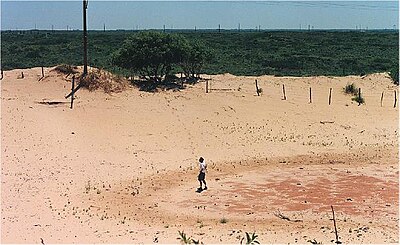
Blowouts are sandy depressions in a sand dune ecosystem (psammosere) caused by the removal of sediments by wind.
Commonly found in coastal settings and margins of arid areas, blowouts tend to form when wind erodes patches of bare sand on stabilized vegetated dunes. Generally, blowouts do not form on actively flowing dunes due to the fact that the dunes need to be bound to some extent, for instance by plant roots. These depressions usually start on the higher parts of stabilized dunes on account of the more considerable desiccation and disturbances occurring there, which allows for greater surface drag and sediment entrainment when the sand is bare. Most of the time, exposed areas become quickly re-vegetated before they can become blowouts and expand; however, when circumstances are favourable, wind erosion can gouge the exposed surface and create a tunneling effect which increases local wind speed. A depression may then develop until it hits a non-erodible substrate, or morphology limits it. The eroded substances climb the steep slopes of the depression and become deposited on the downwind side of the blowout which can form a dune that covers vegetation and lead to a larger depression; a process that helps create parabolic dunes.[1]
Note that volcanic features that take the form of depressions are sometimes informally called blowouts, such as "The Blowout" (a lava lake) or "Big Blowout Butte" in central Idaho.[2]
- ^ Livingstone, Ian, and Andrew Warren. Aeolian Geomorphology: An Introduction. Wesley Longman Limited, 1996. Print.
- ^ Kuntz, M.A., Skipp, Betty, Champion, D.E., Gans, P.B., Van Sistine, D.P., and Snyders, S.R., 2007. Geologic map of the Craters of the Moon 30' X 60' quadrangle, Idaho. U.S. Geological Survey, Scientific Investigations Map SIM-2969. Map Scale: 1:100,000.